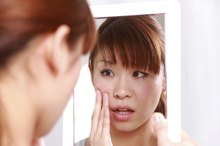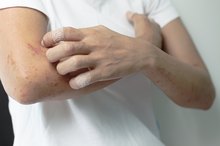Face Wash Allergy Symptoms
Exposure to certain ingredients in face washes, cosmetics and other skincare products can cause allergic contact dermatitis in some people 1. While sensitivity to substances differs from person to person, some compounds -- such as perfumes -- initiate allergy symptoms more often than others. Simple skin irritation will leave mild red patches, while true allergies create a host of skin symptoms. Learn which facial care ingredients trigger allergic reactions so you can avoid including them in your daily routine.
Skin Itching and Stinging
Itching or stinging sensations in the skin may be your first sign of irritation from a product. These symptoms may begin immediately after contact with a substance or as many as 10 days later, if it is a patient’s first incidence of contact. When the skin absorbs the allergenic ingredients in facial cleansers, the body sends histamines into the blood. These chemicals cause uncomfortable skin itching. Most contact dermatitis allergy symptoms take place at the point of exposure 1. Face wash, however, can drip and splash, and either a few or all areas of contact may be affected.
- Itching or stinging sensations in the skin may be your first sign of irritation from a product.
- These symptoms may begin immediately after contact with a substance or as many as 10 days later, if it is a patient’s first incidence of contact.
Eye Problems
Detergent Allergy Symptoms
Learn More
If irritating skincare ingredients reach your eyes, your may experience allergic conjunctivitis 2. The symptoms of this condition include red and itchy eyes, which may become watery and overflow with tears. Like skin problems, long-term eye symptoms can create lasting damage, so take steps to identify and remove the allergenic substance from your environment. Read product ingredient labels to associate your allergy symptoms with specific skincare formulas. A doctor’s advice may be necessary to determine the component of the product that might be causing the reaction.
- If irritating skincare ingredients reach your eyes, your may experience allergic conjunctivitis 2.
- Like skin problems, long-term eye symptoms can create lasting damage, so take steps to identify and remove the allergenic substance from your environment.
Inflammation
Chemical elements in fragrances, dyes and preservatives most often cause allergic contact dermatitis 1. Even after rinsing off an allergenic face wash, the inflammation caused by common allergens such as formaldehyde or alpha hydroxy acids progresses. Facial skin may show redness in patches. Allergic reactions to skincare products often result in painful, bumpy or swollen rashes caused by inflammation. You may experience rashes that are dry, crusty and scaly, or blister-like lesions that can grow and ooze fluid. These areas are susceptible to skin infection.
- Chemical elements in fragrances, dyes and preservatives most often cause allergic contact dermatitis 1.
- Allergic reactions to skincare products often result in painful, bumpy or swollen rashes caused by inflammation.
Related Articles
References
- Cleveland Clinic: Contact Dermatitis
- Cleveland Clinic: Conjunctivitis
- Bains SN, Nash P, Fonacier L. Irritant contact dermatitis. Clinical Reviews in Allergy & Immunology. 2018;56(1):99-109. doi:10.1007/s12016-018-8713-0
- Owen JL, Vakharia PP, Silverberg JI. The Role and Diagnosis of Allergic Contact Dermatitis in Patients with Atopic Dermatitis. Am J Clin Dermatol. 2018;19(3):293–302. doi:10.1007/s40257-017-0340-7
- Uter W, Werfel T, White IR, Johansen JD. Contact allergy: A review of current problems from a clinical perspective. Int J Environ Res Public Health. 2018;15(6):1108. doi:10.3390/ijerph15061108
- Robinson M, Visscher M, Laruffa A, Wickett R. Natural moisturizing factors (NMF) in the stratum corneum (SC). I. Effects of lipid extraction and soaking. J Cosmet Sci. 2010;61(1):13-22.
- Cheng J, Zug KA. Fragrance allergic contact dermatitis. Dermatitis. 2014;25(5):232-245. doi:10.1097/der.0000000000000067
- Deza G, Giménez-Arnau AM. Allergic contact dermatitis in preservatives. Current Opinion in Allergy and Clinical Immunology. 2017;17(4):263-268. doi:10.1097/aci.0000000000000373
- Bleasel N, Tate B, Rademaker M. Allergic contact dermatitis following exposure to essential oils. Australasian Journal of Dermatology. 2002;43(3):211-213. doi:10.1046/j.1440-0960.2002.00598.x
- Fransen M, Overgaard LEK, Johansen JD, Thyssen JP. Contact allergy to lanolin: temporal changes in prevalence and association with atopic dermatitis. Contact Dermatitis. 2017;78(1):70-75. doi:10.1111/cod.12872
- Brasch J, Becker D, Aberer W, et al. Guideline contact dermatitis: S1-Guidelines of the German Contact Allergy Group (DKG) of the German Dermatology Society (DDG), the Information Network of Dermatological Clinics (IVDK), the German Society for Allergology and Clinical Immunology (DGAKI), the Working Group for Occupational and Environmental Dermatology (ABD) of the DDG, the Medical Association of German Allergologists (AeDA), the Professional Association of German Dermatologists (BVDD) and the DDG. Allergo J Int. 2014;23(4):126–138. doi:10.1007/s40629-014-0013-5
- Martin SF, Rustemeyer T, Thyssen JP. Recent advances in understanding and managing contact dermatitis. F1000Res. 2018;7:F1000 Faculty Rev-810. doi:10.12688/f1000research.13499.1
- Tan CH, Rasool S, Johnston GA. Contact dermatitis: Allergic and irritant. Clin Dermatol. 2014;32(1):116-124. doi:10.1016/j.clindermatol.2013.05.033
- Verhulst L, Goossens A. Cosmetic components causing contact urticaria: a review and update. Contact Dermatitis. 2016;75(6):333-344. doi:10.1111/cod.12679
Writer Bio
Nancy Clarke began writing in 1988 after achieving her Bachelor of Arts in English and has edited books on medicine, diet, senior care and other health topics. Her related affiliations include work for the American Medical Association and Oregon Health Plan.









